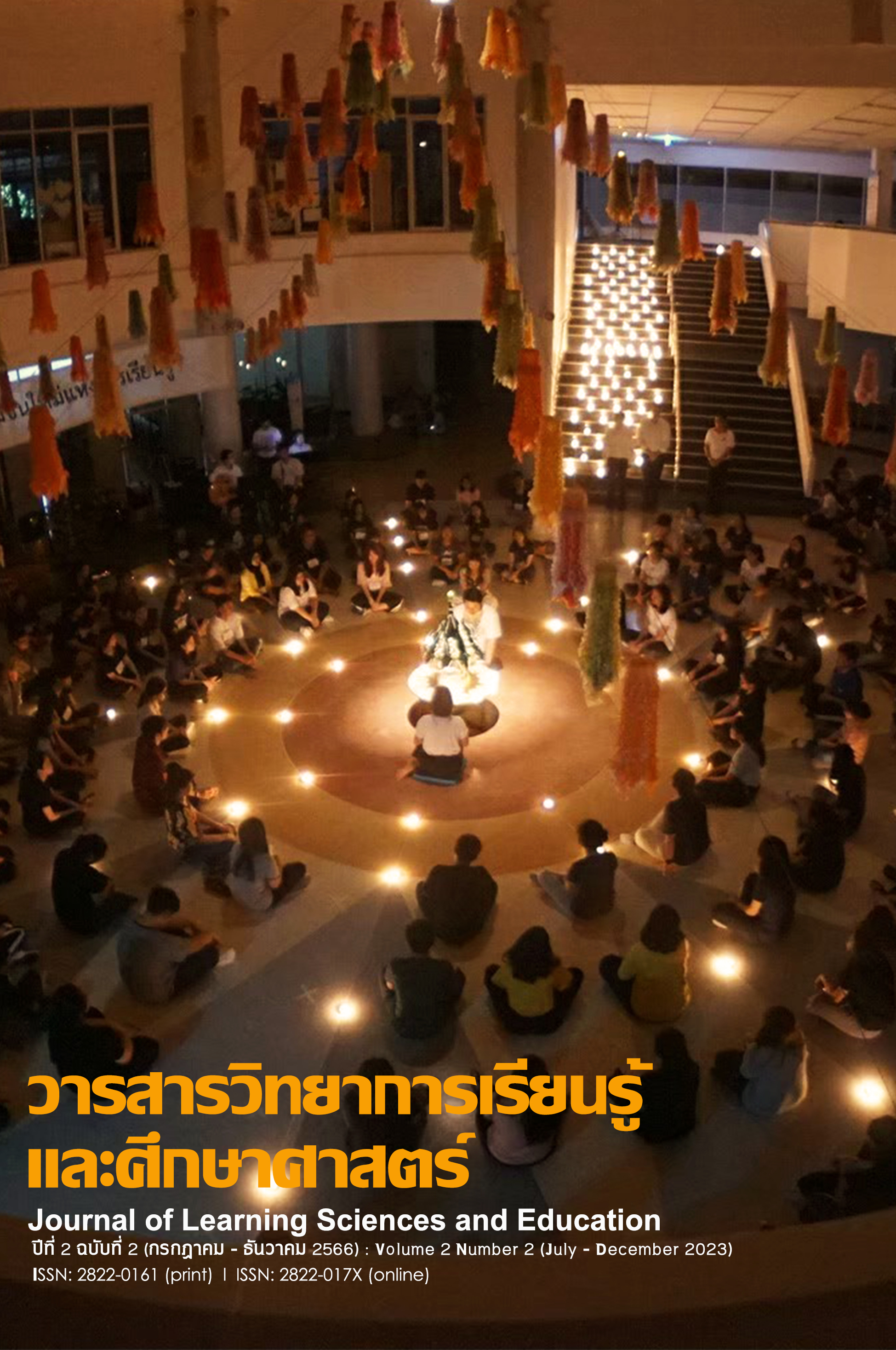Under the Regime of Images and Fear: Myths about Sex Learning in Thai Education and the Missing Role of Thai Schools in Supporting Sex Learning
Main Article Content
Abstract
Sex education and sex learning are challenging issues Thai education. Sex learning contributes to sexual literacy, positive attitudes toward sexuality, and proper practice. Nonetheless, Thai society still limits communication about sex, and people avoid talking about this topic in public. Thai schools as “learning spaces” are expected to combine traditional values with knowledge about sex, resulting in Thai students having to seek knowledge about sex in private within the school context.
This multidisciplinary research combined sociological and psycho-neuroscientific approaches using critical discourse analysis and studying participants’ attitudes and satisfaction with sex learning. The research aimed to 1) investigate myths about sex learning in Thai schools; and 2) study the impact of myths about sex learning on the wellbeing of teachers and students in the Thai educational system. This research applied the Regime of Images and Culture of Fear to analyze the myth of sex learning within the Thai context.
Findings showed that schools did not provide safe spaces for teachers and students to learn about sex. In addition, suppressing sex learning to protect a positive image of school could affect relationships among people within schools. This research encouraged Thai schools to adjust their attitudes and roles regarding sex learning.
Article Details

This work is licensed under a Creative Commons Attribution-NonCommercial-NoDerivatives 4.0 International License.
References
Agardh, A., Cantor-Graae, E., & Östergren, P. O. (2012). Youth, sexual risk-taking behavior, and mental health: a study of university students in Uganda. International journal of behavioral medicine, 19, 208-216.
Bernal-Morales, B., Rodríguez-Landa, J. F., & Pulido-Criollo, F. (2015). Impact of anxiety and depression symptoms on scholar performance in high school and university students. A Fresh Look at Anxiety Disorders, 225.
Blommaert, J., & Bulcaen, C. (2000). Critical Discourse Analysis, Annual Review of Anthropology, 29, 447-466.
Diaz-Bone, R., Bührmann, A. D., Rodríguez, E. G., Schneider, W., Kendall, G., & Tirado, F. (2008). The Field of Foucaultian Discourse Analysis: Structures, Developments and Perspectives, Historical Social Research, 33(1), 7-28.
Diener, E., Emmons, R. A., Larsen, R. J., & Griffin, S. (1985). The Satisfaction with Life Scale. Journal of Personality Assessment, 49, 71-75.
Elias, N. (1984). The civilizing process (Vol. 2). Oxford: Blackwell.
Ewing, D. (2000). The fall of eve: racism and classism as a function of sexual repression, Jean Ait Belkhir, Race, Gender & Class Journal, 7(1), 10-21.
Furedi, F. (2015). The moral crusade against paedophilia. In V. E. Cree, G. Clapton, & M. Smith (Eds.), Revisiting Moral Panics (201-210). Bristol: Bristol University Press.
Garland, D. (2012). The culture of control: Crime and social order in contemporary society. University of Chicago Press.
Glassner, B. (2004). Narrative techniques of fear mongering, Social Research: An International Quarterly, 71(4), 819-826.
Harris, S.M., & Hays, K.W. (2008). Family Therapist Comfort with and Willingness to Discuss Client Sexuality. Journal of Marital and Family Therapy, 34, 239-250.
Hendrick, C., Hendrick, S. S., & Reich, D. A. (2006). The brief sexual attitudes scale. Journal of Sex Research, 43, 76-86.
Jackson, P. A. (2004). The Thai regime of images. SOJOUR: Journal of Social Issues in Southeast Asia, 19(2), 181-218.
Jackson, P. A. (2011). Queer Bangkok - 21st century margets, media, and right. Hong Kong: Hong Kong University Press.
Jeffrey, L. A. (2002). Sex and Borders. Vancouver, University of British Columbia Press.
Ligneul, R., Girard, R., & Dreher, J. C. (2017). Social brains and divides: the interplay between social dominance orientation and the neural sensitivity to hierarchical ranks. Scientific reports, 7, 45920.
Magelinskaitė, Š., Kepalaitė, A., & Legkauskas, V. (2014). Relationship between social competence, learning motivation, and school anxiety in primary school. Procedia-Social and Behavioral Sciences, 116, 2936-2940.
Morris, R. C. (1994). Three sexes and four sexualities: redressing the discourses on gender and sexuality in contemporary Thailand. Positions. 2(1). 15-43.
National Statistical Office, & UNICEF. (2016). การสำรวจสถานการณ์เด็กและสตรีในประเทศไทย พ.ศ. 2558-2559. [Multiple Indicator Cluster Survey 2015-2016]. Bangkok, UNICEF Thailand.
Nomejko, A., & Dolińska-Zygmunt, G. (2014). The sexual satisfaction questionnaire–psychometric properties. Polish Journal of Applied Psychology, 12(3), 105-112.
Office of the Education Council, UNICEF, Mahidol University, & Thammasat University. (2016). รายงานผลการวิจัยเพื่อทบทวนการสอนเพศวิถีศึกษาในสถานศึกษาไทย. [Review of Comprehensive Sexuality Education in Thailand]. Bangkok, UNICEF Thailand.
Pegado, F., Hendriks, M. H., Amelynck, S., Daniels, N., Bulthe, J., Masson, H. L., ... & de Beeck, H. O. (2018). Neural Representations Behind ‘Social Norm’ Inferences in Humans. Scientific reports, 8(1), 12943.
Shonkoff, J. P., Levitt, P., Boyce, W. T., Cameron, J., Duncan, G., Fox, N., ... & Thompson, R. (2010). Persistent fear and anxiety can affect young children’s learning and development. Retrieved February, 15, 2018.
Singer, J. (1994). Boundaries of the soul: The practice of Jung's psychology, Rev. Anchor Books/Doubleday.
Smith, S., & Haythorn, W. W. (1972). Effects of compatibility, crowding, group size, and leadership seniority on stress, anxiety, hostility, and annoyance in isolated groups. Journal of Personality and Social Psychology, 22(1), 67.
Steimer, T. (2002). The biology of fear-and anxiety-related behaviors. Dialogues in clinical neuroscience, 4(3), 231.
Sukamongkol, S. (2014). การบริหารจัดการความขัดแย้งทางการเมืองในประเทศไทย ระหว่างปี พ.ศ. 2544 – 2555. [Political Conflict Management in Thailand during the Years 2001-2012] KASEM BUNDIT JOURNAL, 15(1), 39–55. Retrieved from https://so04.tci-thaijo.org/index.php/jkbu/article/view/25259
Townsend, R. (2019). The adulterer: censorship, morality, and foreign films in Thailand, Journal of Women’s History, 31(1), 86-108.
Uenal, F. (2016). Disentangling islamophobia: The differential effects of symbolic, realistic, and terroristic threat perceptions as mediators between social dominance orientation and islamophobia. Journal of Social and Political Psychology. 4(1), 66-90.
Vignoli, M., Muschalla, B., & Mariani, M. G. (2017). Workplace phobic anxiety as a mental health phenomenon in the job demands-resources model. BioMed research international, 2017.
Vohs, K. D., Glass, B. D., Maddox, W. T., & Markman, A. B. (2011). Ego depletion is not just fatigue: Evidence from a total sleep deprivation experiment. Social Psychological and Personality Science, 2(2), 166-173.

